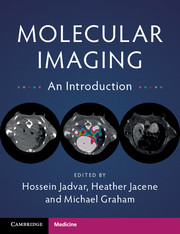Book contents
- Frontmatter
- Contents
- List of Contributors
- Preface
- 1 Instrumentation – CT
- 2 MRI/ MRS Instrumentation and Physics
- 3 Optical and Ultrasound Imaging
- 4 Instrumentation-Nuclear Medicine and PET
- 5 Quantitation-Nuclear Medicine
- 6 Perfusion
- 7 Metabolism
- 8 Cellular Proliferation
- 9 Hypoxia
- 10 Receptor Imaging
- 11 Apoptosis
- 12 Angiogenesis
- 13 Reporter Genes
- 14 Stem Cell Tracking
- 15 Amyloid Imaging
- Index
1 - Instrumentation – CT
Published online by Cambridge University Press: 22 November 2017
- Frontmatter
- Contents
- List of Contributors
- Preface
- 1 Instrumentation – CT
- 2 MRI/ MRS Instrumentation and Physics
- 3 Optical and Ultrasound Imaging
- 4 Instrumentation-Nuclear Medicine and PET
- 5 Quantitation-Nuclear Medicine
- 6 Perfusion
- 7 Metabolism
- 8 Cellular Proliferation
- 9 Hypoxia
- 10 Receptor Imaging
- 11 Apoptosis
- 12 Angiogenesis
- 13 Reporter Genes
- 14 Stem Cell Tracking
- 15 Amyloid Imaging
- Index
Summary
Introduction to CT
Computed tomography (CT) uses x-rays to generate cross-sectional tomographic images and differs from conventional projection radiography where a snapshot image is taken with a fixed geometry between the x-ray source, the object, and the image receptor. In projection radiography, structures at different depths in the imaged object are superimposed in 2-D, whereas in CT, the 2-D superposition of structures is virtually eliminated. Advanced 3-D-rendered CT images can also be created as needed when contiguous tomographic slices are acquired by a helical acquisition.
CT provides excellent contrast resolution that is far superior to plain-film radiography. However, CT does have inferior spatial resolution relative to plain-film radiography, and does impart substantially more of a radiation dose to patients. Nonetheless, continual advances in CT technology over time have allowed for its practical application in diverse clinical settings, such as with CT colonography, CT angiography, and CT urography for detailed evaluation of colon, vasculature, and urothelial system, respectively.
The CT image is created, in very basic terms, by reconstruction from a large number of projections, each of which consists of many rays or measurements of x-ray transmission, through a patient. In effect, CT attempts to determine the internal anatomy of the patient by using x-ray projections created at multiple different angles. A typical medical CT scanner is shown in Figure 1.1. In this configuration, the patient lies on the table, and is moved into the opening in the gantry to the desired position. Unseen but inside the gantry are the x-ray tube and detectors, which rotate around the patient. The detectors measure the transmission projections at each of the various angles as the x-ray tube rotates around the patient. After the projections are acquired, a computer is used to reconstruct slices through the patient. The images are then sent to a computer workstation for clinical review.
Concepts of Attenuation and CT Number
The building blocks for a CT image are a series of transmission measurements of individual rays through the patient, utilizing a thin pencil-like x-ray beam and detectors, as shown in Figure 1.2. The detectors measure the intensity of the transmitted beam, I. The relative transmission is defined as the ratio −ln(I/I0), where I0 is the intensity of the beam entering the patient and is equal to the product of two properties of the patient, the x-ray attenuation coefficient, µ, and the thickness, t.
- Type
- Chapter
- Information
- Molecular ImagingAn Introduction, pp. 1 - 10Publisher: Cambridge University PressPrint publication year: 2017



